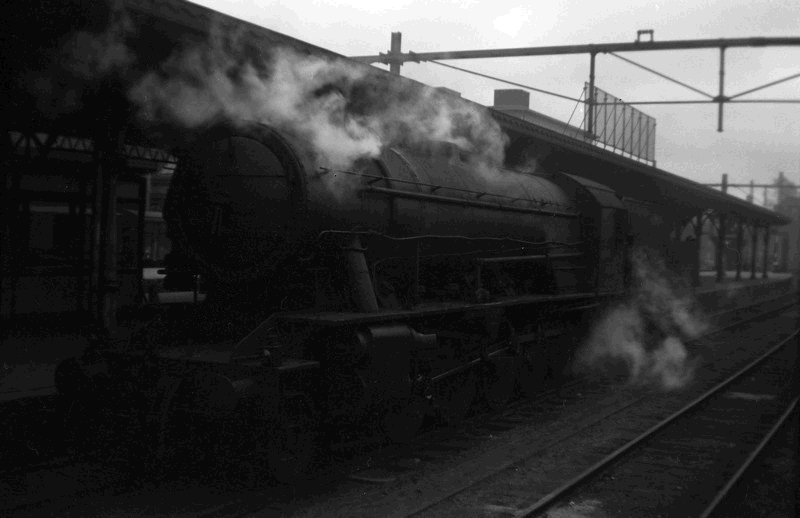
previous page (March and April 1946)
LATE SPRING 1946 (May and June)
It was after the return journey from England, which
began on April 30th 1946, that I decided to keep a separate detailed diary of my
journeys on the Reichsbahn. With railway news from the Press, railway workings
etc. I could clearly see that it would be a most interesting form of record,
over and above the usual spotter's record of loco observations, dates and
places. What follows from this point comes mainly from these two parallel
diaries. On May 1st, the leave train from the Hook turned off at Utrecht and ran
via Arnhem to Nijmegen. We changed engines here and had a W.D. 2-10-0 with a
German crew. In the station was a Dutch train in charge of a W.D. 2-8-0
running from Roosendaal to Amsterdam and carrying blue Wagon-Lits coaches from
Brussels to Amsterdam. What a contrast this train was to the aged Dutch
passenger stock and the drab green German coaches. The broken bridges down the
Dutch rivers meant that all traffic, rail and road had to make the detour, miles
to the east, to Nijmegen. The frontier at Kranenburg was easily recognised by
the much higher quality sleepers and ballast used in Germany. The Dutch track
seemed to be laid on sand or smooth round pebbles with sleepers like something
from cowboy days on the American plains. There was terrible battle destruction
all the way past Kleve and Goch almost as far as Krefeld. The Reichswald forest
fighting of February and March 1945 had been here. The track on this line (KBS
470) had been largely singled. Kevelaer was a big station for a small village.
It had many through platforms with awnings. I found later that this was to accommodate
pilgrimage trains
to the shrine of Our Lady of Kevelaer in a great church in the village. W.D.
2-10-0s 73772
and 73772 were working near Krefeld. One of the Prussian P10 4-6-0s
17.218 was seen at Krefeld and also one of the four-cylinder engines 17.1175. At
Krefeld Hbf., under the huge arched station roof, 03.197 took over and hauled us
all the way to the barracks siding at Münster. For the first few miles we ran
along the multiple track towards the destroyed bridges over the Rhine between
Rheinhausen and Duisburg. We turned off to the north along KBS 476 and crossed
over the river by a two-span, apparently undamaged bridge near Baerl. The train
went over very slowly and then down to the junction with KBS 300 south of
Oberhausen. We were held at the junction and a horde of children, young and
older, ran alongside calling for bread and our sandwiches. “Haben Sie Brot’,
was the cry and there followed a shower of bags of sandwiches, cigarettes,
loose and in packets, and even coffee. I wondered later if the engine crew
stopped here deliberately to let this happen. At Oberhausen, I remembered a
photo in the 1935 ‘Railway Wonders of the World’ in an article about some of
the more remarkable German stations of the '30s. I recognised the rather
unusual station frontage as we passed. It was getting dark now and apart from
the long line of steelworks on either side of the four-track line through
Gelsenkirchen I saw nothing but two BR 78s at Wanne-Eickel and then the
signal lights as we ran through Dortmund Hbf.. The station buildings were in
ruins but the track work seemed to have been restored. The next day in Münster,
I decided to try to return to Winterberg by rail as I was alone on this journey
and could please myself. I had a short wait at Münster Hbf. and there was the
usual procession of BR 50s on goods trains passing both through and behind the
station. A P-train from Rheine to Hamm came in and I got in the 2nd class,
padded seats and quite clean, rather like being in a Midland Railway clerestory
coach on the pre-war Lancaster to Morecambe electrics. The train engine was
38.3467 of Bw Dortmund Hbf. and like all other locos had a branch of tree
greenery fastened to the upper lamp bracket, something to do with May Day I
believe. In Hamm station was a BR 01 Pacific and three other undamaged but derelict
0ls at the nearby shed. From Hamm to Hagen I took another P-train
going from Hamm to Köln-Deutz, but this time it was packed and I was lucky to
get a seat in a queer long-wheelbase 4-wheel van converted for passenger use
with wooden bench seats. There was nothing going at that time from Hagen on KBS
360 so I left the station and hitchhiked in Military trucks to Bestwig and
caught the usual early evening train up to Winterberg, behind 93.996.
I
now began to note the traffic on the line through Winterberg using a pair of
binoculars. The small Gasthaus which we took over in May 1945 in the village
centre was now the sergeant’s Mess.. All the Radar and Wireless people lived
about a quarter of a mile out of the village on Road 236 in a small hotel which
overlooked the deep valley south of Winterberg. The railway dropped down a very
steep incline from the station and through a short curved tunnel under the
village centre, emerging in this valley, the Nuhnetal. There was a saw mill,
rail linked, just down the line and the whole stretch of line was overlooked by
our side of the hotel. The Unit H.Q. and Orderly Room and the Unit main
Wireless station were here also. We W.T. Operators worked sometimes at the Hotel
and sometimes at the Tech. site which had its own radio station. This nearness
to Authority never bothered me; I reasoned that the safest place is always right
under the light. The only unusual working I saw at this time was an
unidentifiable BR 50 üK running south in mid-May.
One
day when off-duty, I thought of visiting Wuppertal, but the truck broke down in
Olsberg so I set off hitching. At 1330 I was only at Neheim and it looked like
rain so I decided to cut it short and return by
train. I caught P607,from Hagen to Warburg, at Neheim behind 38.3542.
Three
German railway police in the Dienstabteil looked rather unfriendly at first, but
soon brightened up and we got talking . The train was, of course, packed and
probably many of the passengers were going out to try to find potatoes etc. I
heard later that the British and American occupation authorities were trying to
stop this endless travelling to collect food. In Germany now, this unhappy
period of history is called ‘die Hamsterjahre’, which means pretty well what
it sounds like, a compulsive collecting of food ‘Just in case’. The west
viaduct at Arnsberg was still unrepaired, with a walking pace speed restriction
over it. There was shuttering in place for concrete and steel arch repairs, but
nothing further. The policeman said that small bombs had smashed the two arches
and not the big block-buster which had been dropped to cause the whole tunnel
end to collapse. Fortunately, it had only blasted the tunnel mouth. All around
the gorge were numerous small bomb craters. From the way all the railway men
talked about the tunnel and viaduct attack, I got the impression that it was
something they must relate to everyone who showed any interest at all, a kind of
‘mini’ Bielefeld viaduct attack. At Bestwig, on shed, was 44.1316 üK newly
painted in shining black and red, a very splendid sight. In contrast, further on
at Nuttlar was 38.3409
newly done in
plain black and most surprisingly with a round Wannen-tank tender still in
camouflage, clearly off a Kriegslok.
In the next off-duty time. I went for a day spotting on the main line east of Olsberg, near the foot of the incline. From 0900 to 1739 there were 13 loco movements only, one a BR 78 banker returning to Bestwig, a new type on this duty. But the one thing that made the day unforgettable was a Kassel to Düsseldorf train of eight old, non-corridor, clerestory eight-wheelers behind 01 .212 of Bw. Hagen Eckesey. This train and the opposite working were P341 and P342, later becoming E-trains. O1s from Eckesey shed, of which more later, were evidently used on it, a welcome sign of improvements on the line. The coaching stock that day was like nothing more than a set of David Bain or Clayton clerestory non-corridors on the old Midland. Going back, I evidently had to walk quite a long way towards Winterberg, because there was no military traffic, and I took the narrow-gauge Steinhelle—Medebach train from Steinhelle to Niedersfeld. The engine was a 0-8-2T with outside cylinders built in 1926; S.M.E No. 5. This line, now long closed, ran by the main roadside from Steinhelle towards Winterberg and at Niedersfeld turned east and finally reached the large upland village of Medebach by a series of remarkable reversing inclines. I regret now not looking more at this line, which was so near to Winterberg, and which seems almost as eccentric in its own way as the famous Obstfelderschmeide Bergbahn in the DDR.
Nearer the end of the month, a weeks apart, I had my two longest trips yet, to Hagen and Schwerte. On the first I went as far as Wuppertal to see a British civilian police official. He simply told me to get in touch with Army N.C.O.s in charge at the main stations and give his name if there were difficulties. So forthwith, I hitched straight to Hagen. In my diary, I see no mention of the Wuppertal ‘hanging railway’, the ‘Schwebebahn’. I vaguely remember seeing steel-work at one point over the river. Perhaps it was not then back in working order. At Hagen Eckesey shed, a big depot, two damaged 17s, 17.276 and 17.288, both of Bw Aachen were present together with six BR 41s. Most of these were in camouflage livery. The foreman told me about these splendid engines on troop trains, especially those from the East Front, though they had been intended for fast freight when introduced just before the War.
My 1944 Kursbuch showed many of these trains as DmW and SFR (D-trains with ‘Wehrmachtteil’ and ‘Schnellfronturlauberzüge’. The SFRs had limited accommodation for civilians and often ran from strange places in Eastern Europe to the big German cities, for soldiers on leave. In sidings near Schwerte shed were two strangers, 58.300 (a former Baden railways loco of Prussian G12) and a very small camouflaged 0-8-0; 55.171 lettered ‘Ostbahn’.
Back at the station, I had a close look at 39.149 of Bw Hamm standing there light, a very fine looking engine indeed, built by Henschel at Kassel in 1924. I saw now that it was a three-cylinder class. It was strange how the foreman had spoken of both the 39s and 41s, and the same day I had been able to look closely at two examples of the classes. I went back to Bestwig that evening behind 01 .228 of Hagen Eckesey shed in P341 and set off from Bestwig to hitch. My luck was out, for once, as I only got to Bigge by Army truck and had to walk the rest of the way, about 17km and it soon went dark and then began to drizzle. It was a long walk indeed and I finally slipped into the hotel about 2am.
JOURNEYS IN THE AMERICAN ZONE
Please note that no photos were taken in the U.S.Zone as G.E.Rabone's presence there was unauthorised and he felt it better not to draw too much attention to himself!
This long tramp home rather put me off travel in the British Zone and I decided to try my luck in the U.S.Zone which began only a few miles south of Winterberg. I never fancied being stopped and questioned by British Military Police and judged, correctly it turned out, that a British uniform, a British pass (even fictitious) and above all, a British accent, would see me through. Furthermore, by this time we were working a four-watch system which gave me a fair amount of off-duty time. So between early June and late July, I made four long journeys into the northern part of the U.S.Zone. They were within what is now Hessen. During two of them I stayed overnight in a transit barracks the Americans had set up in a large underground air-
The first trip was a day-outing to
Giessen (KBS 520),
behind 93s to Frankenberg and then on KBS 530 to Cölbe and Marburg. Train D80 (Kassel to Frankfurt) ran past
us near Cölbe, behind 01.1103 (Bw Kassel) and across the temporary Lahn bridge.
At Marburg several U.S. Army 2-8-0s were lying dead; I shouldn’t imagine the
German drivers would think much of these once their own locos started to run
again. D80 was still in Marburg station, so I got in the coach reserved for U.S.
servicemen. Main line trains in the U.S.Zone all carried a coach or two reserved
for troops, unlike the British who preferred to keep all troops off civilian
services and get them on special trains.
As the Pacific accelerated out of
Marburg, I began to
wonder if there were not a L.N.E.R. Pacific in front with the rapid exhaust
beat. I did not realise that the 01.10s were three-cylinder engines. All
the usual DRG and Prussian locos were seen at Giessen with plenty of 50s and a
few 44s. There were one or two of the small 2-6-2Ts of BR64. I decided against
photography and ‘shed-bashing’: better safe than sorry. D375 (Frankfurt—Essen)
came in behind 38.1410 (Bw Frankfurt 1) and reversed. It left for the
north-west behind 39.221 of Bw Dillenburg. It was packed as I have
rarely seen a train packed before or since. This was surprising as it had not
seemed particularly full when I saw it the previous month at Hagen. A curiosity
was 44.358
which had its allocation - Bw Dillenburg - painted on the boiler front and tender side but carried
shed plates for RBD Halle. I returned to Marburg at the end of the afternoon
behind a BR 50 üK on a P-train, in time to get the connecting trains on to
Frankenberg and Winterberg. Another unusual thing at Giessen was a huge painted
slogan on a retaining wall by the shed, ‘Nicht qualmen’ - don’t make
smoke. A particularly striking thing about these lines in the U.S.Zone, at
least, was the number of derelict locos abandoned in sidings at almost every
station along the line and on the north-westerly line out of Kassel (KBS 340).
By this time, I was beginning to distinguish between
parts of a large class such as the BR55 - some quite small; others with high
numbers, much larger, and, the BR 93s with different shapes of cab. The
following day I noted a Bestwig BR 94 0-10-0T at Winterberg which had come up
to collect about 20 empty open wagons. There was a very great shortage of
open wagons at this time and the Russians, who were taking black coal from the
Ruhr district as reparations, were reputed not to be returning the empties; the
coal in the Eastern Zone , unlike in the Western Zones was mainly brown coal or
lignite.
On June 13th, I went again to Marburg on the early
train. An early ‘Kriegslok’was on the main line to Cölbe. I caught D80 again
to Giessen, with the same engine as before. A small 2-6-0 was on Marburg shed,
24.054, the first I had heard or seen of this much-liked class. There was
another sign of restoration at Marburg; 44.847 towing 50.817
As we approached
Kassel, the line from Bebra and
Bavaria (KBS 500) came in on the right and there was the famous Fulda river
viaduct at Guntershausen. Seven of its arches were destroyed and a temporary
wood and steel structure filled the gap. There are good pictures of it in
Gottwaldt's 'Bundesbahn Album 1945-60' and of the present reconstructed one in
‘Die DB Heute’ by Wagner. The complex of junctions at Kassel
‘Bahndreieck’ was much damaged with a lot of track lifted to repair
essentials. The shed did not appear damaged nor, at casual glance, did the
nearby Henschel works seem too bad. The Hbf. with its eleven terminal faces was
in full use, although the station buildings were in ruins. P707 arrived on time
at 1530 behind 01.1104, built by Schwarzkopf of Berlin in 1940 whilst I was
waiting on the platform to take the train out. It was fully streamlined with
small smoke deflector plates on either side of the chimney. Although I had a
good look at it, I still thought it to be merely a BR 01 with streamlined
casing. I left Kassel at 1732 on P640 (Kassel—Altenbeken) behind an unknown P8
(KBS 340). As we passed the shed on the north side, there were
three 'Kriegsloks' with the long condenser tenders. I was a bit worried about
what might happen at the Zone border crossing station at Haueda, but though all
civilians got off and back on the train after showing passes, I stayed in the
train and was not even spoken to. At the next station, Warburg, I changed on to KBS 350
and went on to Bestwig in P616. I saw that the two BR 41s and the damaged BR 42
had gone since my visit on April 4th. The coach was an English-looking
non-corridor eight-wheeler 2nd class and quite clean. At the next station,
Scherfede, the junction of KBS 350 and 249 from Braunschweig and Kreiensen, was
44.577, one of the first of this class I had seen derelict at Bestwig at the
beginning of the year, and now repainted and working from Bw Scherfede. It was
22.15 when we arrived at Bestwig, the last train to arrive that day. A railway
man
suggested I
should go into the trainmen’s restroom near the shed and so I
‘kipped-down’ there on the bench for the night. No one batted an eyelid,
surprisingly, when I told them what I was doing.
Next morning I went up to Winterberg on the 0515 behind 93.999. It seems that I did not go to bed when I landed back, as I noted with binoculars a heavy train of 42 coal empties hauled by 57.2627 and banked by 93.738 coming up the valley from the American Zone.

WD 2-10-0 73715 at Utrecht in May 1946
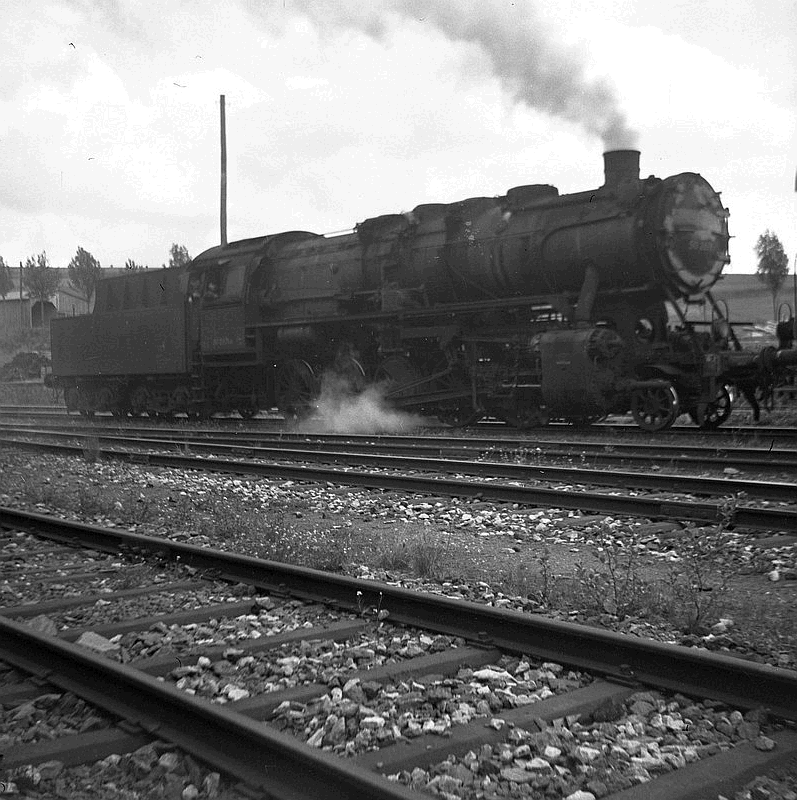
50-2671 ük at Winterberg in May 1946
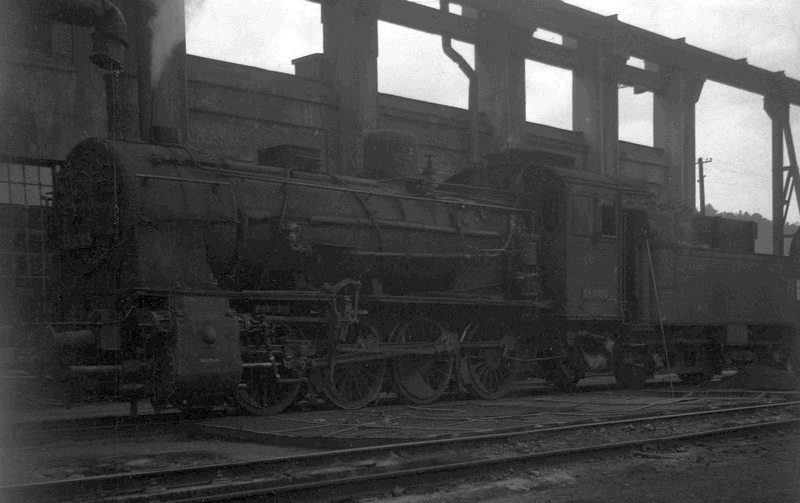
55.1703 at Hagen Eckesay shed on 24th May 1946
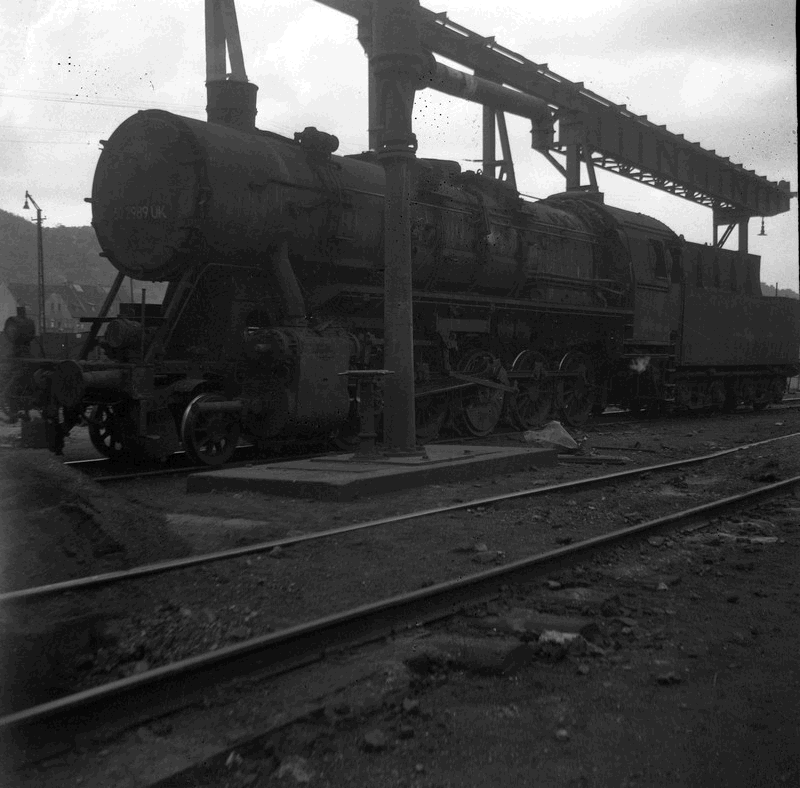
50.2989 at Bw Hagen Eckesay on 24th May 1946.
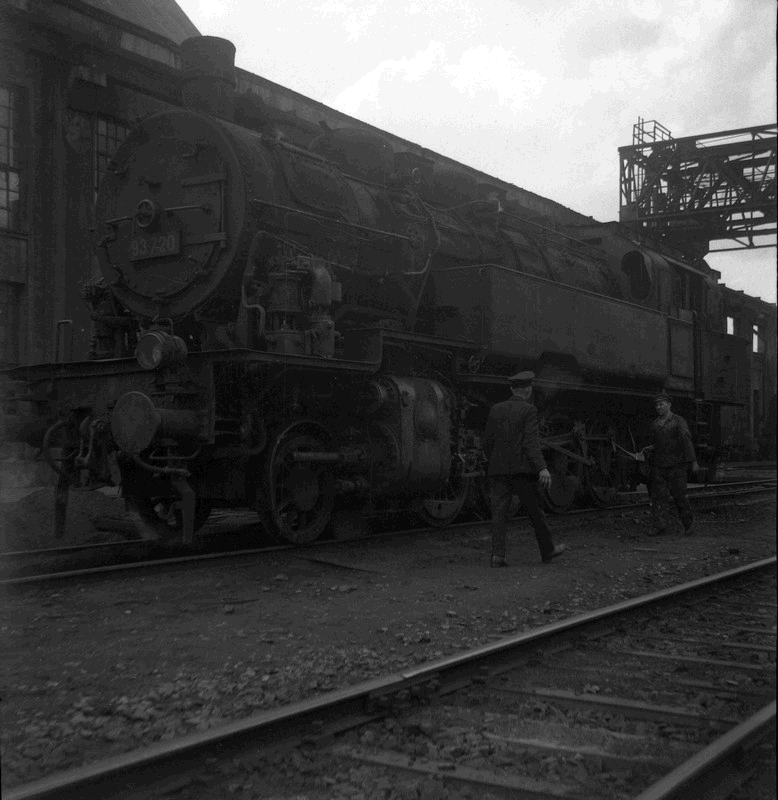
93.720 of Bw Hattingen on shed at Hagen Eckesay 24th May 1946.
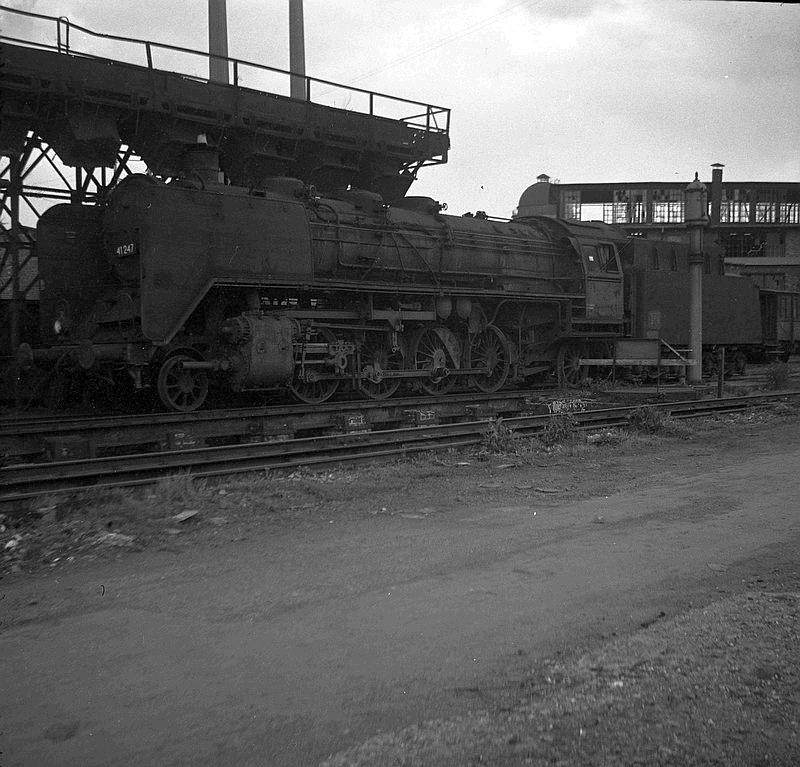
41.247 derelict at Hagen Eckesay shed on 24th May 1946.
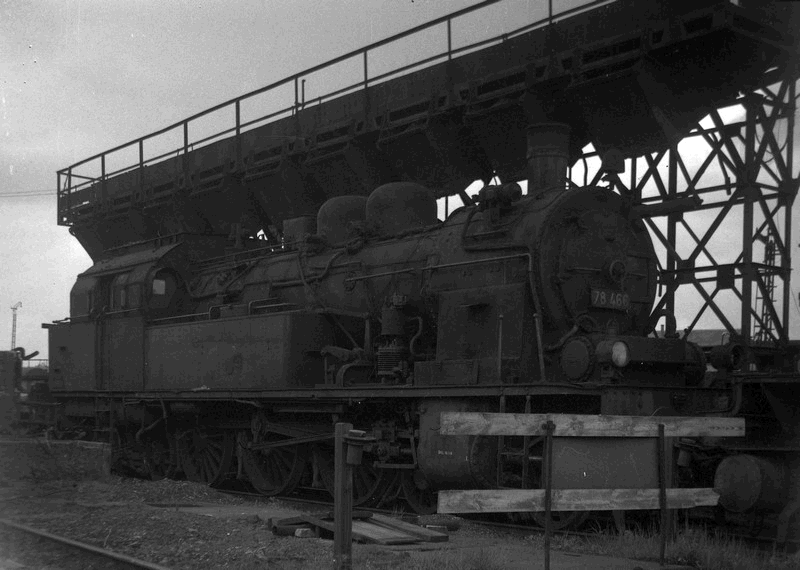
78.466 on shed at Hagen Eckesey 28/5/46.
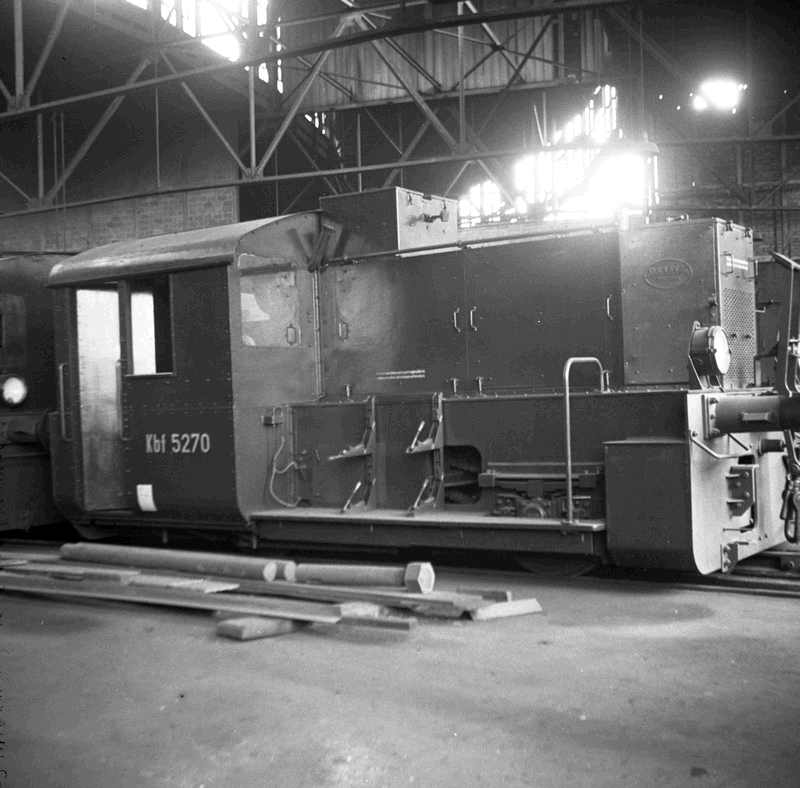
Kleinlok Kbf 5270 at Hagen Eckesay on 24th May 1946
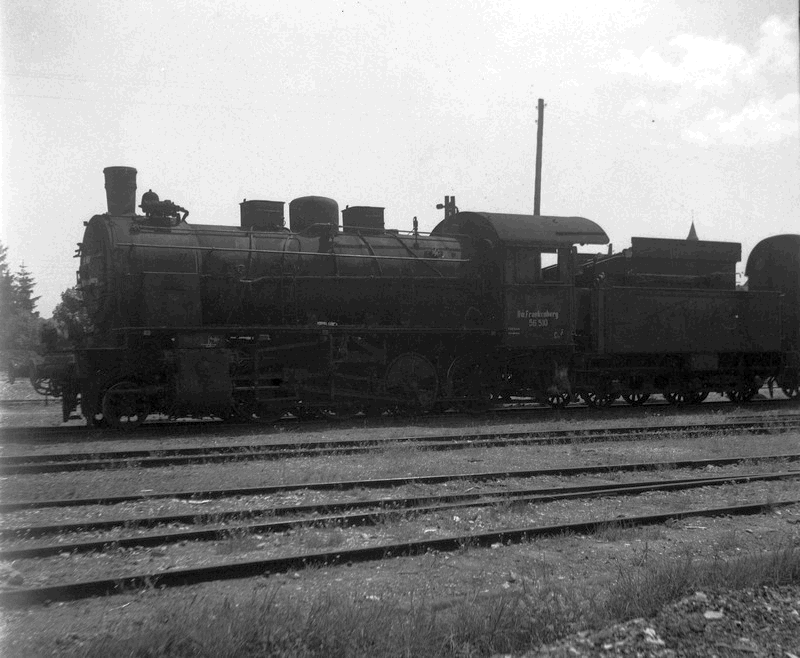
56.510 (Bw Frankenberg) at Winterberg on the 28th May 1946.
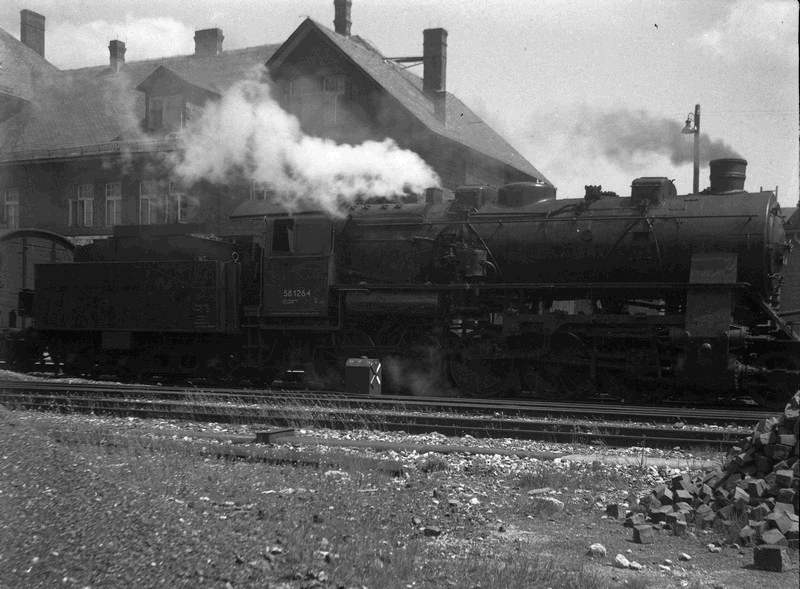
58.1264 newly repainted in black and red at Winterberg on 28th May 1946.
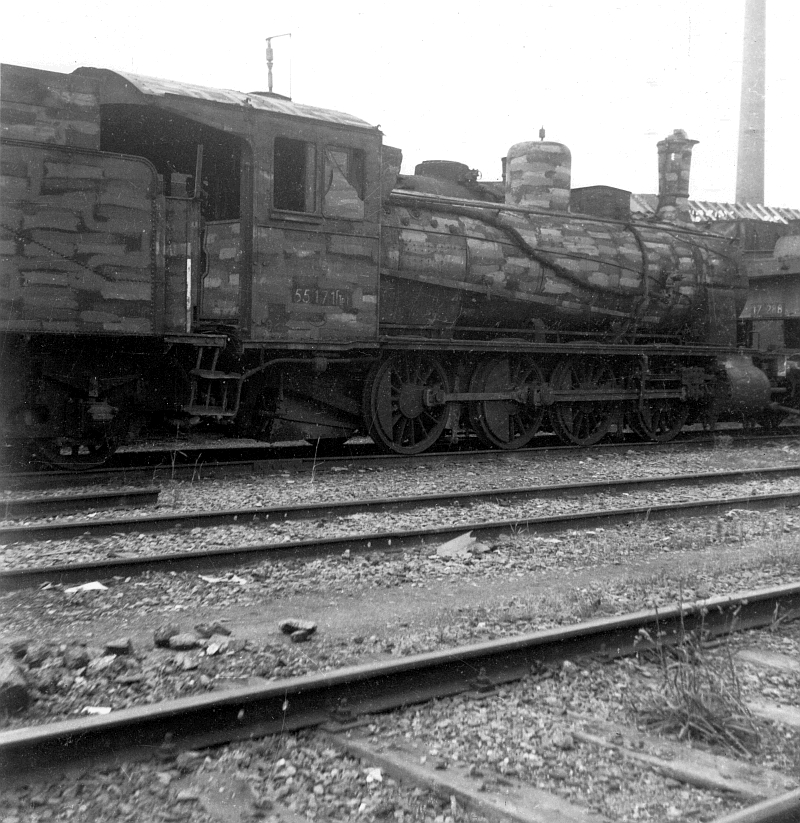
Camouflaged liveried BR55.171 at Schwerte 31/5/46.
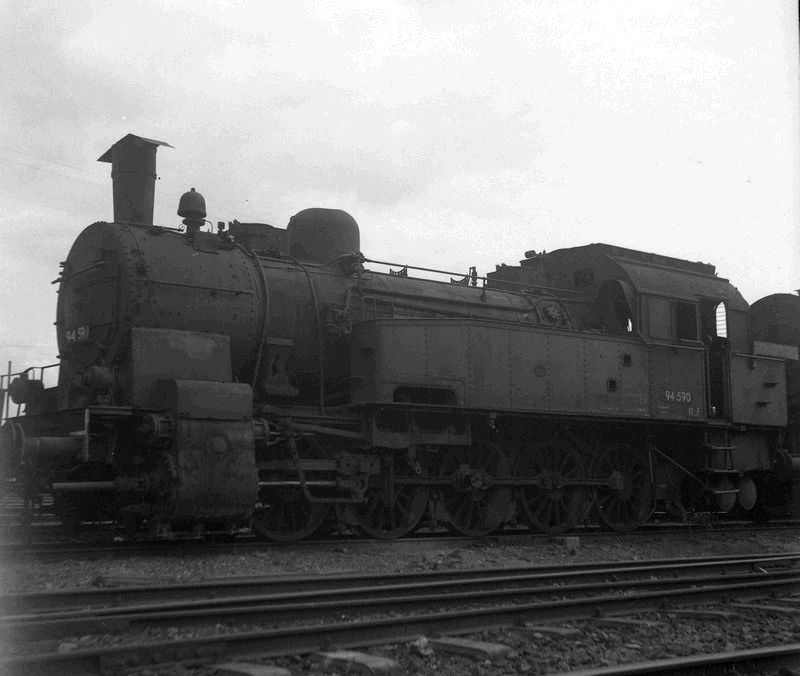
94.590 at Schwerte shed on 31st May 1946.
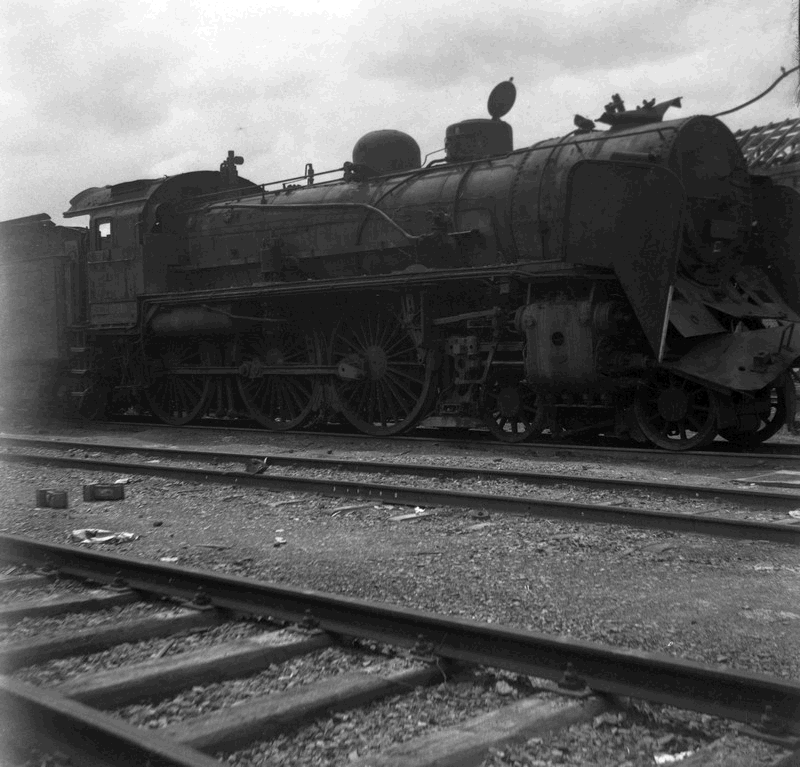
Derelict 17.276 at Schwerte shed on 31st May 1946.
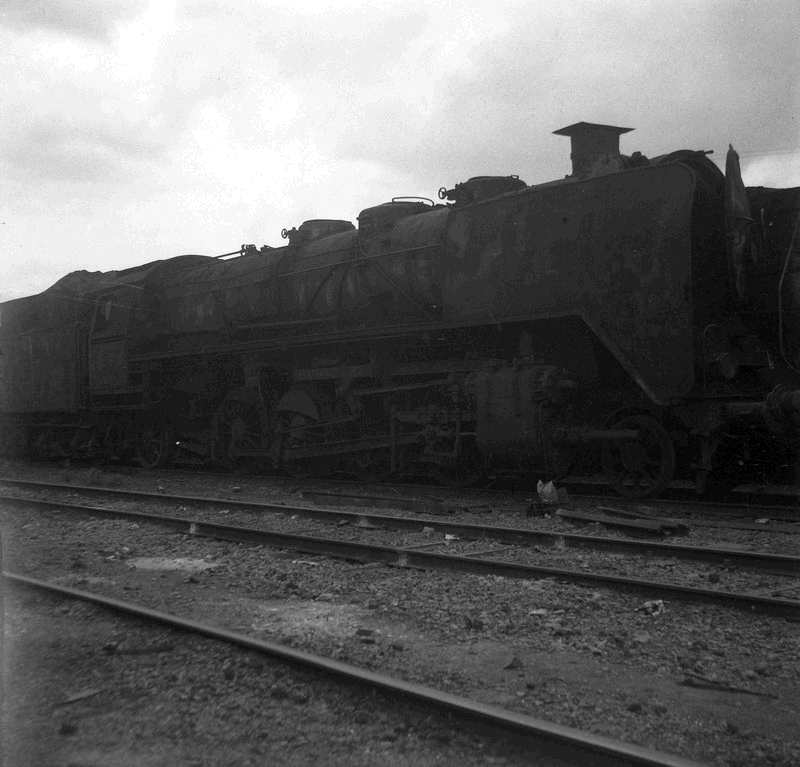
41.094 (believed to be) in camouflage livery at Schwerte shed on 31st May 1946